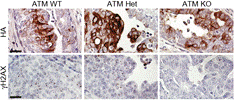Veterinary and Biomedical Sciences, Department of
Document Type
Article
Date of this Version
2011
Citation
Molecular and Cellular Biochemistry (2011) 355: 75-82. DOI: 10.1007/s11010-011-0840-3.
Abstract
Inactivation of the Staphylococcus aureus tricarboxylic acid (TCA) cycle delays the resolution of cutaneous ulcers in a mouse soft tissue infection model. In this study, it was observed that cutaneous lesions in mice infected with wild-type or isogenic aconitase mutant S. aureus strains contained comparable inflammatory infiltrates, suggesting the delayed resolution was independent of the recruitment of immune cells. These observations led us to hypothesize that staphylococcal metabolism can modulate the host immune response. Using an in vitro model system involving RAW 264.7 cells, the authors observed that cells cultured with S. aureus aconitase mutant strains produced significantly lower amounts of nitric oxide (NO•) and an inducible nitric oxide synthase as compared to those cells exposed to wild-type bacteria. Despite the decrease in NO• synthesis, the expression of antigen-presentation and costimulatory molecules was similar in cells cultured with wild-type and those cultured with aconitase mutant bacteria. The data suggest that staphylococci can evade innate immune responses and potentially enhance their ability to survive in infected hosts by altering their metabolism. This may also explain the occurrence of TCA cycle mutants in clinical S. aureus isolates.
Included in
Bacterial Infections and Mycoses Commons, Biochemistry Commons, Biological Phenomena, Cell Phenomena, and Immunity Commons, Immunology of Infectious Disease Commons, Infectious Disease Commons, Medical Biochemistry Commons, Medical Immunology Commons



Comments
Published by Springer. US government work.